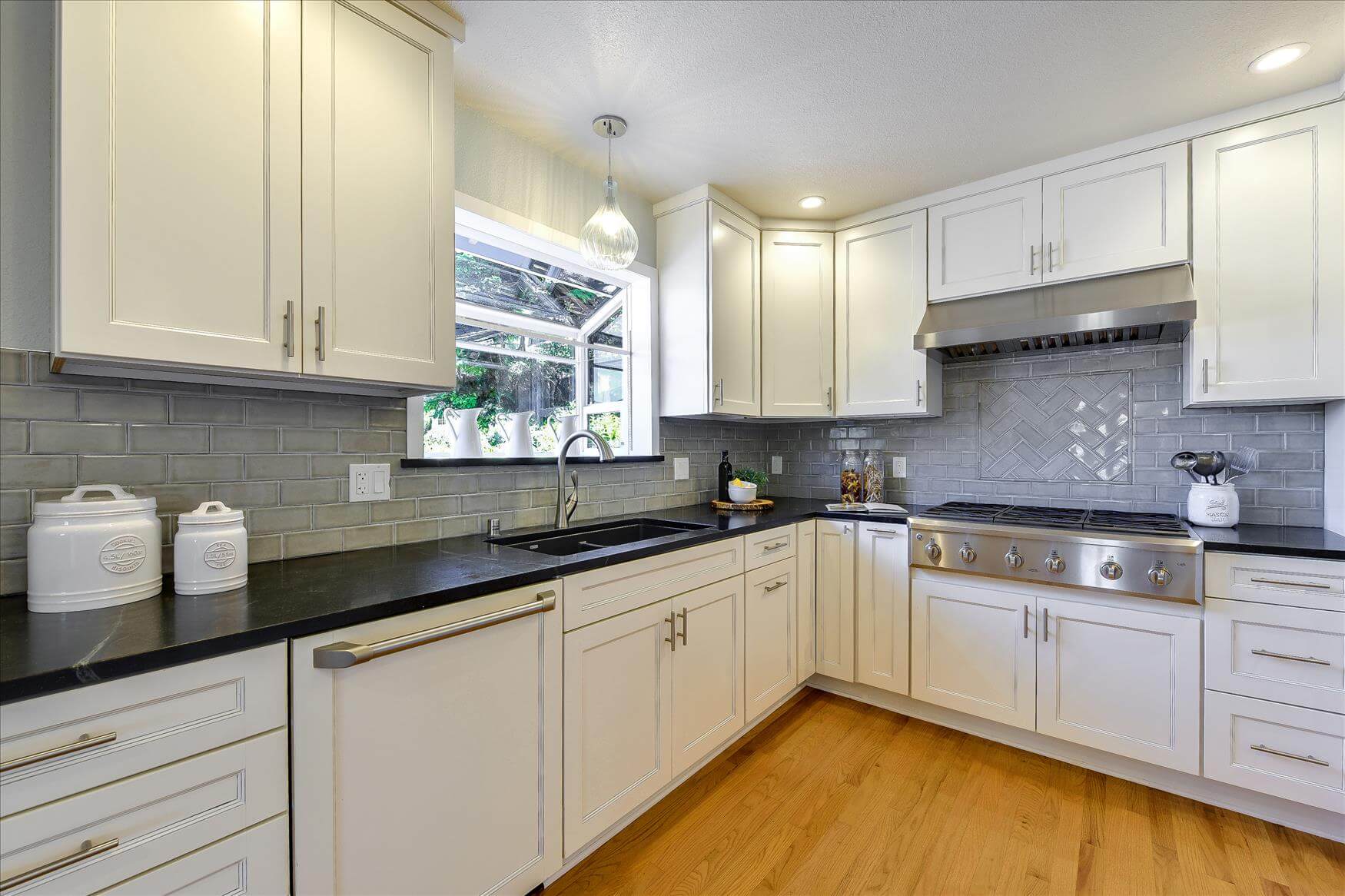A Guide to Budgeting for Your Next Kitchen Remodel

Want to give your kitchen a fresh look? Whether you’re considering selling your home or simply want to switch up your style, a remodel can be a game-changer for your home.
Of course, a kitchen remodel is no small task.
There’s a great deal to consider when planning and executing any home makeover, but the kitchen can be especially complex and expensive to alter.
Your first step is to define a clear budget. Dreaming about new countertops or appliances might be fun, but without a financial plan, things can quickly go off course.
At American Remodelers, we’ve helped countless California homeowners renovate their kitchens, and we’ve worked with a vast range of budgets. We understand the nitty-gritty pricing details, and we want to help plan your kitchen remodel.
In this guide, we’ll break down the steps of budgeting for your remodel and provide some practical tips to ensure your fantasy kitchen doesn’t turn into a financial nightmare.
Let’s take a look.
Step 1: Assess Your Needs and Goals
First things first: understand why you’re remodeling your kitchen and what your goals are. This will dictate the course of your project and its final price tag.
We’ve met homeowners with many different reasons for remodeling. In our experience, here are some of the top incentives for overhauling a residential kitchen:

Outdated or Worn-Out Appliances and Fixtures
Big kitchen appliances like refrigerators, ovens, or dishwashers rarely last more than 15 years. If yours have started to act up, or if they simply look dated, you might want to consider investing in new ones. Replacing your kitchen’s dominant appliances doesn’t just help the space look newer – it can also help boost functionality, conserve energy, and provide a more enjoyable cooking experience.
Improving Energy Efficiency
As we just mentioned, new appliances can help conserve energy in your kitchen – but so can things like energy-efficient lights, better insulation, and eco-friendly materials. We’ve helped many homeowners renovate their kitchens to improve sustainability and lessen their environmental impacts.
Increasing the Home’s Value
Updating a kitchen is one of the best ways to boost a home’s resale value. If your kitchen is worn, dated, or poorly designed, you might struggle to attract potential buyers or sell your home for a great price.
Changing the Aesthetics/Style
Just like any other room in the home, kitchen design trends evolve. Your cooking space might have been “in style” a few years ago, but aesthetic preferences change and renovations are required to keep it up to date.
On the other hand, you might have moved into a home with a kitchen that simply doesn’t suit your taste. Remodeling offers the chance to make valuable updates, but it also allows you to get creative and align the space with your style.
Bettering Functionality and Storage
Lastly, we’ve had many clients update their kitchens to offer more functionality or to add storage space. An organized kitchen can be a joy, but cluttered or ill-designed cooking spaces will drive people away.
Our designers have helped hundreds of homeowners implement ergonomic layouts, clever storage solutions, and user-friendly appliances.
Step 2: Determine Your Ideal Budget

Once you’ve thought long and hard about what you hope to achieve with your kitchen remodel, it’s time to start looking at dollar signs.
Start by evaluating your current financial situation. What can you realistically allocate for expected expenses, as well as unexpected hiccups or fees? Getting familiar with your financial “comfort zone” will help you construct a well-balanced budget.
But now we get to the real calculations – the factors that can increase or decrease the budget of your remodel.
Overall Project Scope
Is this a full remodel, or is it a series of smaller renovations? You’ll need to understand the full scope, size, and complexity of your project before you can begin to assess the cost of materials, labor, and other factors.
Desired Materials
Material choices significantly impact the final price tag of a kitchen remodel. For example, a granite or quartz countertop is going to set you back far more than a laminate option. Similarly, real hardwood floors can be substantially more expensive than vinyl or tile.
Labor and Contractor Costs
As you make plans for your kitchen remodel, speak with local remodeling companies and contractors to understand what their prices include. These businesses may have different pricing models and services, so compare them carefully as you draw up your budget.
Permits and Fees
Some permits and fees may be required, depending on your project. In California, most simple remodels can be finished without a permit, but some counties require you to obtain a permit if you’re replacing kitchen countertops or other major elements.
As such, it’s a good idea to check with local authorities to determine if you’ll need to pay for inspections, documents, etc.
Additional Features or Upgrades
Custom additions can contribute to the overall functionality and aesthetic appeal of your new kitchen, but they’ll also contribute to the overall price tag. Make sure you’re accounting for these “bonus” features as you budget.
Understand the ROI of a Kitchen Remodel
The Remodeling Cost vs. Value Report for 2023 states that homeowners can expect a return of 30.7% to 85.7% on their investment in a new kitchen if they sell their home.
Of course, the exact amount you’ll recoup depends on many factors, but generally, homeowners can increase their property’s value by tens (if not hundreds) of thousands of dollars.
We’re not saying you should max out your budget in hopes of reaping a financial reward when you sell your home, but it’s certainly worth considering the future return on your investment.
Step 3: Research Cost Estimations
Now that you have a list of all the factors to consider when building your budget, it’s time to research costs and crunch numbers.
Start by gathering material and labor cost estimates from various sources. This will help you ensure accuracy and secure the best value for your kitchen remodel, rather than just agreeing to a contractor’s first estimate.
As you do your homework and speak to professionals, you’ll likely realize that kitchen remodeling costs can vary widely.

In California, construction costs tend to be higher than those of many other states. Estimates put the average “midrange major kitchen remodel” at about $88,200, and “upscale” remodels can easily jump past $170,000.
With such a wide price gap, the only real way to know what your project will cost is to speak with multiple contractors in your area.
Considering DIY-ing Your Kitchen Remodel?
Although remodeling your kitchen by yourself offers substantial cost savings, it comes with its fair share of drawbacks, such as:
- Extended project timelines
- A high risk of errors
- The need for specialized skills (plumbing, electrical work)
We’re not saying you can’t update your own kitchen. However, we highly recommend researching all of the details before weighing the pros and cons of a DIY remodel. You might find that the possible downsides, risks, and stress overshadow the cost savings.
Step 4: Explore Your Financing Options

There are many different ways to pay for a kitchen remodel. Here are some of the most common financing avenues for California homeowners:
Personal Savings
Some homeowners can finance their kitchen remodels with savings. This is often the simplest and easiest option, but it can also leave you cash-poor or without an emergency fund if you’re not careful.
Personal Loans
Many clients apply for a personal loan. With this type of financing, you receive a lump sum of money that must be repaid, with interest, in monthly installments. Most come in amounts of $1,000 to $100,000, but some homeowners may qualify for larger amounts.
These loans don’t require collateral, meaning approval and the loan’s annual percentage rate are based on information like your credit and income.
Home Improvement Loans
A home improvement loan is a personal loan that can be used specifically to pay for home repairs, renovations, or remodels. These are usually lump-sum, fixed-rate loans that offer lower interest rates than credit cards and predictable monthly payments.
This kind of loan is used to pay for work on your home, but it is not backed by your property equity. Therefore, it may have a higher interest rate and shorter repayment terms than the next option we’ll discuss.
Home Equity Loans
A home equity loan allows homeowners to borrow a fixed amount of money using their home equity as collateral. It typically involves a fixed interest rate and set monthly payments over a specified loan term.
The primary difference between a personal (or home improvement) loan and a home equity loan lies in the collateral.
A personal loan is unsecured, meaning it doesn’t require any asset as collateral. In contrast, a home equity loan, or a home equity line of credit (HELOC), is secured by the equity in your home. Because they use your property as collateral, they introduce the risk of foreclosure if repayments are not met.
Cash-Out Refinancing
With this mortgage refinancing option, you replace your existing mortgage with one for more than you currently owe. You then receive the difference in cash, which you can use to cover your kitchen remodeling expenses.
This can be advantageous for those looking to fund significant renovations. However, you should carefully consider the impact on your mortgage terms, interest rates, and overall financial situation.
Credit Cards
Credit cards are immensely convenient and flexible. Homeowners can make immediate purchases of materials, fixtures, and appliances, and some cards offer rewards programs or cashback incentives to help offset the cost of the remodel.
However, credit cards also come with significantly higher interest rates compared to other financing options. You’ll need to carefully manage your spending, pay attention to the card’s interest rates, and develop a solid plan for repayment to avoid accumulating heavy debt.
Contractor Financing
Many contractors collaborate with lenders to offer clients financing options for remodeling projects. This may cover various aspects, including materials, labor costs, and other expenses.
The terms of contractor financing, as well as the interest rates and repayment plans, can vary depending on the lender and the specific program offered.
This option can provide a streamlined, convenient way to fund a kitchen remodel, but you’ll still need to carefully review the financing terms and understand any fees involved to ensure it aligns with your financial goals and preferences.
Government Grants Or Loans
These are financial assistance programs provided by federal, state, or local government agencies to support home improvement projects. They aim to encourage homeowners to invest in renovations that enhance energy efficiency, safety, or overall property value.
To access government grants or loans for a kitchen remodel, homeowners typically need to apply through the relevant government agency. The application process may involve demonstrating the need for the renovation, outlining the proposed changes, and providing information about the property and household.
While grants do not need to be repaid, loans usually come with favorable terms and low interest rates.
401(K) Loans or Withdrawals
Some homeowners decide to borrow money from a retirement savings account to fund their kitchen remodels.
With a 401(k) loan, you borrow funds from your own account and repay them with interest, typically over a five-year period. On the other hand, a 401(k) withdrawal involves taking money out of the account, but this option may incur taxes and penalties, especially if you’re under the age of 59½.
While tapping into your 401(k) can provide quick access to funds, it comes with downsides. Both loans and withdrawals impact your long-term retirement savings, so carefully consider the implications and explore all of your financing options before pulling the trigger.
FHA 203(K) Renovation Loan
This is a government-backed loan designed to facilitate both the purchase of a home and its renovation. In other words, if you’re moving into a home that requires rehabilitation, this program will help you finance the remodeling costs.
With this option, homeowners apply through an FHA-approved lender, and the loan is subject to approval based on the projected value of the property after improvements.
Regardless of your chosen financing solution, make sure it aligns with your current situation and goals. It may be worth seeking guidance from a financial advisor or trusted friend as you sort through your various options.
Step 5: Look for Ways to Cut Costs

There are many ways to keep your costs down during a kitchen remodel – without sacrificing quality. Here are some of the recommendations we often make to our clients who have limited budgets:
Limit Big Structural Changes
If you can avoid the need for extensive construction and engineering work in your remodel, likely by keeping the existing layout, you’ll significantly reduce the time and expenses associated with the project.
Minimize Custom Features
Custom features come with a custom price tag. If you’re trying to keep your costs low, consider choosing off-the-shelf cabinets, countertops, and fixtures.
Refinish Instead of Replacing
Refinishing instead of replacing items in your kitchen can give it a fresh look – without the expense of new installations. This saves on material costs and significantly minimizes labor expenses.
Avoid “Luxury” Items
High-end appliances, custom cabinetry, and premium countertop materials will certainly inflate your remodeling costs. Instead, consider budget-friendly alternatives that are still high-quality and functional.
Choose Cost-Effective Materials
You can certainly save money by opting for laminate or butcher block countertops over expensive stone options. Similarly, consider durable flooring alternatives like vinyl or laminate. These choices are still stylish but will help keep your project costs in check.
Step 6: Create a Contingency Plan
Remember: you need to plan for unforeseen events and setbacks – and that means having a contingency plan (and budget).
We recommend reserving around 10-20% of the total kitchen remodel cost for accidents and delays. Think of this as your “safety net.”

Tips for Avoiding Expensive Setbacks
(1) Establish clear communication with contractors
Everyone should be on the same page regarding project goals, timelines, and challenges. Clear communication helps prevent misunderstandings and enables timely problem-solving – which in turn reduces the risk of pricey mistakes.
(2) Properly convey budget information to the builders and designers
Openly discuss your financial constraints with your contractor. This allows for realistic planning, ensures the selection of cost-effective materials, and helps create a design that meets your aesthetic preferences and financial parameters.
(3) Create a realistic timeline for the contractor
A well-planned schedule allows for efficient coordination of tasks, timely ordering of materials, and the identification of potential issues before they escalate.
(4) Document all changes and costs
A detailed record ensures clarity on project adjustments and helps track expenses against the budget. It also provides a reference point for you and your contractor, fostering a smooth, accountable renovation process.
Start Your Kitchen Remodel Today
Whether it’s a full remodel or a few renovations, American Remodelers is here to make your dream kitchen a reality. We’ve worked with all kinds of budgets and clients, and we’re confident we can meet your financial expectations.
To learn more about budgeting for a kitchen remodel or discuss your design goals, get in touch. Book a free consultation or call 650-307-3221 to get started.



